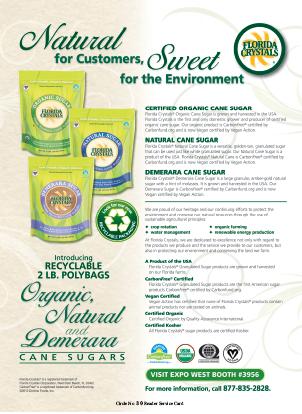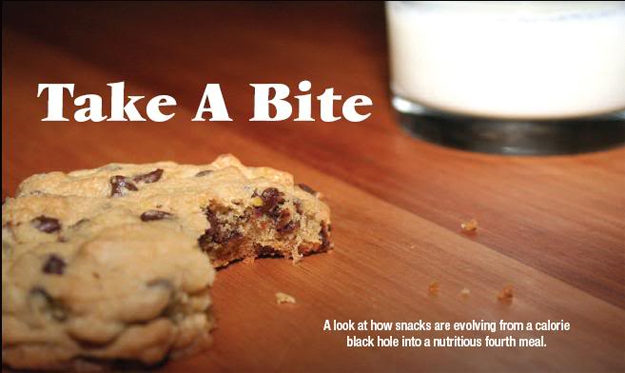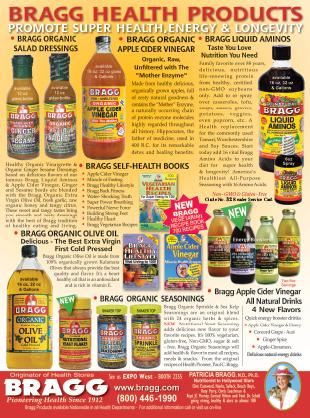The snack foods industry is smack-dab in the middle of a busy intersection. Barreling toward it from one direction are busy, on-the-go lifestyles that necessitate meal stand-ins and nutritious ways to ward off energy crashes. Meanwhile, snacks are being stampeded with a mandate for healthy ingredients that satisfy special diets (low-fat, gluten-free, low-calorie and more). And, consumers want great flavor and texture to boot. What’s the industry to do? Well, it doesn’t seem daunted in the slightest, as snack makers are offering numerous delicious and nutritious chips, cookies, puffed snacks and the like.
Says Matthew Brennan, quality control director of Pirate Brands (formerly Robert’s American Gourmet Food, LLC), Sea Cliff, NY, “Today’s snack consumer is an educated one; the first thing a consumer does is flip over the bag to read the nutritionals. Consumers have and will continue to demand better-for-you, healthier snacks.”
Nicole Dawes, co-founder and CEO of Late July Organic Snacks, Barnstable, MA, makes the point that busy parents like her rely on snacks as integral parts of their children’s daily routines. “That is not changing. It’s something that’s part of our society,” she states, adding, “Snacks should be something that parents can look to not just to provide calories, but also some additional nutrition as well.”
 The Fourth Meal
The Fourth Meal
In a 2009 market report called, Snack Foods Culinary Trend Mapping Report, written by the Center for Culinary Development (CCD) and Packaged Facts, CCD CEO Kimberly Egan stated, “Snacks are less and less the hunger-soothing bridge between formal meals. They have become valuable gastronomical events in their own right especially as consumers demand more from their snacks” (1).
Shoppers want snacks that offer the nutrition of a small, fourth meal, but there’s a catch, believes Ann Jones Kazemzadeh, president of Kay’s Naturals, Inc., Clara City, MN. “Consumers seem to be looking for a way to have bang for their caloric buck—‘How can I eat something I enjoy without adding pounds?’ So, they are looking for low-calorie snacks and desserts that have good texture and flavor with low calorie count.”
Examples of how snack makers are coping with this need include the addition of extra fiber (2–3 grams) to foods that traditionally don’t have much like pudding or yogurt. Jones Kazemzadeh says that her company’s line of snacks pays close attention to this need, too. “Our 28-gram servings carry 10 grams of protein and three grams of fiber, making them an ideal grab-n-go mini meal that will satisfy your hunger. The products are light and crunchy in texture and have great flavor.” Such products include low-calorie Cookie Bites (110 calories per serving) in honey almond and cinnamon almond, and incorporate some interesting healthy ingredients like soy protein, almond butter and pea fiber.
Dawes suggests that key ingredients in healthy snacks are whole grains, and it’s not just health food fanatics who are screening their snacks for these nutritious ingredients. “As a mother, it’s something that I’m looking for in snacks. And as a manufacturer, I’m looking for ways to incorporate more whole grains into the things that we make,” she states. An example is their new whole grain-rich mini-cookies. “I really wanted them to be a good source of whole grains,” Dawes states. “I’m not opposed to giving my sons cookies. They’re a fun and sometimes necessary part of life. But if I am going to give them a cookie, I want it to have some nutritional benefits.”
|
Bits and Bites
|
Another strategy for offering tasty, highly nutritious snacks is to help consumers do their own baking at home. One company, 1-2-3 Gluten Free, Inc., Orange, OH, has developed baking mixes and recipes geared at adding extra nutrition in some unconventional ways. Says Kimberlee Ullner, founder and president, “Our brownies can be made egg-free utilizing chick peas. What a great way to sneak protein and fiber into your child’s diet. Our pancake mix includes buckwheat flour to add additional vitamins and essential amino acids.” The mixes are also a good source of dietary fiber, protein and copper, and a very good source of folate and manganese, according to Ullner.
One thing some companies are opting out of, however, is general enrichment because of procurement issues. “We have a real challenge,” Dawes notes. “We’ve made the decision not to significantly enrich our products because I was not able to find a general vitamin blend that doesn’t come from China.” Ultimately, Late July ended up enriching its cookies with extra calcium that was sourced from the Caribbean and has a U.S. manufacturing plant.
Hit the Sweet Spot. In the past few months, WholeFoods has covered shoppers’ backlash against high-fructose corn syrup and their embracing of natural sweeteners like stevia/rebiana. The snack foods industry is certainly not exempt from this trend. Kay’s Naturals sweetens its Cookie Bites with stevia and cane sugar to keep the sugar content down to three grams per serving. Likewise, 1-2-3 Gluten Free offers sugar-free mixes so consumers can add their own sweeteners like agave. Late July uses evaporated cane juice, but isn’t ready to move to agave or other sweeteners because it’s not abundantly available as an organic raw material.
According to Susan Rosenthal Jay, vice president of marketing and exports at Hillside Candy, Hillside, NJ, her company’s GoNaturally organic candy gives adults a better option than traditional sweets, in part because it’s not overly sweet. She states, “The sweetener is organic brown rice syrup…[it is] a better, healthier sweetener than highly refined tapioca syrup.” Rosenthal Jay adds that her line of candy also meets another trend: the desire for upscale, gourmet options. Hillside’s U.S.-made candy line is certified organic by a “rigorous and exacting” certifier, and has the look to go with it. “The stand-up pouch bag is upscale in appearance, which suits an organic product well,” she explains.
 The call for healthier versions of old favorites is also something salty snack makers have observed. Says Julie Dunmire, brand director for Kettle Foods, Salem, OR, “In the past few years, we’ve continued to see an increased appetite for healthier snacks, even from consumers who historically purchased regular potato chips. Consumers who love potato chips definitely still want delicious, crunchy chips in bold, layered flavors but they’re also looking for lower calorie, lower fat options that deliver across the board.”
The call for healthier versions of old favorites is also something salty snack makers have observed. Says Julie Dunmire, brand director for Kettle Foods, Salem, OR, “In the past few years, we’ve continued to see an increased appetite for healthier snacks, even from consumers who historically purchased regular potato chips. Consumers who love potato chips definitely still want delicious, crunchy chips in bold, layered flavors but they’re also looking for lower calorie, lower fat options that deliver across the board.”
To meet these needs, Kettle offers baked potato chips that are made from whole slices of real potato. According to Dunmire, this means that snackers get the benefits of potassium and fiber from potatoes without the fat and calories. “A satisfying serving of 20 chips has only 120 calories, three grams of fat and two grams of fiber—and tastes delicious,” she states. The company recently launched Salt & Fresh Ground Pepper in the baked variety.
Similarly, lovers of puffs and popped snacks don’t have to feel left out of the healthy loop. Notes Brennan of Pirate Brands (maker of Potato Flyers, Smart Puffs, Original Tings and Pirate’s Booty in flavors like New York Pizza), “We’ve eliminated fryers and trans-fats from all of our products and keep the ingredients simple…We have a continuous improvement program to test and qualify new ingredients or wholesome additives.”
Waking Up the Taste Buds
Without a doubt, you’ve noticed consumers embracing flavors from around the globe. Shoppers love the spicy and savory tastes that Thai and Indian foods offer, for example. Perhaps it is this interest in something new and unexpected that has increased demand for unique and interesting snack foods. Brennan calls one trend “full meal flavors.” He explains, “The most interesting new flavors and flavor combinations in the snack category that I’ve seen include roasted chicken and thyme, Thai, pickle—you name it!”
 One leader in this area is Kettle Foods, which has developed all-natural potato chips in flavors ranging from Tuscan Three Cheese to Death Valley Chipotle. Says Dunmire, “As the natural food industry has grown, consumers aren’t as worried that natural foods will taste bland and are more adventurous in their flavor choices…In the last few years, we have found that there has been strong demand for creamy, cheesy flavors like our new flavor Fully Loaded Baked Potato and comfort food flavors like Sweet Onion and our best-selling Salt & Fresh Ground Pepper.”
One leader in this area is Kettle Foods, which has developed all-natural potato chips in flavors ranging from Tuscan Three Cheese to Death Valley Chipotle. Says Dunmire, “As the natural food industry has grown, consumers aren’t as worried that natural foods will taste bland and are more adventurous in their flavor choices…In the last few years, we have found that there has been strong demand for creamy, cheesy flavors like our new flavor Fully Loaded Baked Potato and comfort food flavors like Sweet Onion and our best-selling Salt & Fresh Ground Pepper.”
Unique tastes aren’t just about salty snacks. Late July Organic Snacks also has launched some unique flavors with its Vanilla Bean with Green Tea and Dark Chocolate (with real chocolate) sandwich cookies. Likewise, the firm also has a special look for its kids’ mini cookies; they are stamped with pictures of endangered animals to teach children about conservation and 10% of the proceeds go to the Jane Goodall Institute.
There’s an interesting dichotomy in the snacks category today. While shoppers are looking for new, exciting flavor combinations, they also crave familiar flavors. But, according to Ullner, they’re making their own special twists. “People are going back to basics and this is driving production of some of the more interesting and flavorful snacks/desserts on the market. For example, 1-2-3 Gluten Free Sweet Goodness Pan Bars can be made in pumpkin, apple spice, zucchini, sweet potato, banana and carrot flavors—all of which are popular.”
 The Kay’s Naturals line is another place where the “new meets old” trend is apparent. “The market today is full of clean, savory flavors…My favorite flavor right now is honey because it’s naturally simple and it adds that rich, warm taste we all love. We use it in our Honey Almond cereals, Jalapeno Honey Mustard pretzels and our Honey Cookie Bites,” comments Jones Kazemzadeh. The Kay’s Naturals line also includes Protein Chips, Protein Cereals, Protein+ Cookie Bites, high-protein Kruncheeze, pretzel sticks, twists, and snack mixes in savory flavors, such as Parmesan, Chili Nacho Cheese and Sweet Barbeque and sweet flavors such as French Vanilla.
The Kay’s Naturals line is another place where the “new meets old” trend is apparent. “The market today is full of clean, savory flavors…My favorite flavor right now is honey because it’s naturally simple and it adds that rich, warm taste we all love. We use it in our Honey Almond cereals, Jalapeno Honey Mustard pretzels and our Honey Cookie Bites,” comments Jones Kazemzadeh. The Kay’s Naturals line also includes Protein Chips, Protein Cereals, Protein+ Cookie Bites, high-protein Kruncheeze, pretzel sticks, twists, and snack mixes in savory flavors, such as Parmesan, Chili Nacho Cheese and Sweet Barbeque and sweet flavors such as French Vanilla.
Other great examples of traditional flavors with a twist include the newest offerings from Snikiddy Snacks of Boulder, CO. Mary Schulman, co-founder and executive vice president of marketing at the company, states, “With the addition of our Baked Fries to our existing Baked Cheese Puffs, we now offer not only unique products, but also terrific flavor combinations.” Such tastes include classic, comfort food-inspired flavors, which exemplify Brennan’s observation of “whole meal” flavors: Classic Ketchup Fries, Parmesan Garlic Fries, Cheddar Cheese Fries, Original Fries, Grilled Cheese Puffs, Mac n’ Cheese Puffs, Nacho Cheese Puffs and Pizza Puffs.
Square One
Before you bring in the latest and greatest snacks available to natural/organic shoppers, it warrants reiterating that retailers should check labels for health-conscious consumers. Says Schulman, “They are looking at nutritional information and ingredients to find the amount of fat and sodium and to make sure ingredient ledgers are clean.”
Take Schulman’s point about sodium to heart, as it’s something most Americans need to cut back on. In May 2009, the Centers for Disease Control and Prevention stated that we shouldn’t consume more than 2,300 mg of sodium per day; most Americans should consume far less (no more than 1,500 mg/day) (2).
An amount of 2,300 mg sounds like a lot, but many Americans are consuming triple this amount or more. A recent Reuters article stated that men take in 10.4 grams and women take in 7.3 grams of sodium per day. And, the number is rising. The article also indicated that cutting back on one’s sodium intake would make a tremendous difference in many people’s lives. “A reduction of one gram would prevent 11,000 to 23,000 strokes, 18,000 to 35,000 heart attacks and 15,000 to 32,000 deaths from any cause,” according to new research presented in the New England Journal of Medicine (3).
One can anticipate that the natural snack market will continue to respond to the need for low-sodium options and for healthier ways to quell hunger in between meals with unique and tasty foods. WF
References
- Packaged Facts, Snack Foods Culinary Trend Mapping Report (Rockville, MD, 2009).
- Centers for Disease Control and Prevention, “Most Americans Should Consume Less Sodium (1,500 mg/Day or Less),” www.cdc.gov/Features/Sodium/, accessed January 25, 2010.
- G. Emery, “Salt Reduction Could Save 92,000 Lives a Year,” Reuters, www.reuters.
com/article/idUSTRE60K0VP20100121?feedType=nl&feedName=ushealth1100, accessed January 25, 2010.
Published in WholeFoods Magazine, March 2010


 There’s a lot to learn about snack foods. Chew on these snack facts compiled by popchips (1):
There’s a lot to learn about snack foods. Chew on these snack facts compiled by popchips (1):








